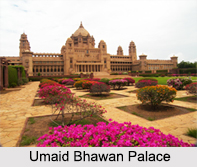 The Umaid Bhawan Palace is an outstanding piece of Rajasthan"s heritage, and a symbol of new Jodhpur. It is a home of the former Jodhpur royal family and at present is the world"s sixth-largest private residence. The Umaid Bhawan Palace is located at Jodhpur in the Indian state of Rajasthan. It is last among the magnificent Palaces constructed in India and was built between 1929 and 1944. The Palace is named after the Late His Highness Maharaja Umaid Singhji, which has been his residence as well, his successors. The Palace was constructed as a drought relief measure and the aim was to provide employment to nearly three thousand people affected by the successive years of drought.
The Umaid Bhawan Palace is an outstanding piece of Rajasthan"s heritage, and a symbol of new Jodhpur. It is a home of the former Jodhpur royal family and at present is the world"s sixth-largest private residence. The Umaid Bhawan Palace is located at Jodhpur in the Indian state of Rajasthan. It is last among the magnificent Palaces constructed in India and was built between 1929 and 1944. The Palace is named after the Late His Highness Maharaja Umaid Singhji, which has been his residence as well, his successors. The Palace was constructed as a drought relief measure and the aim was to provide employment to nearly three thousand people affected by the successive years of drought.
History of the Umaid Bhawan Palace
The past of the Umaid Bhawan Palace is connected to a curse by a saint who had said that a period of deficiency will go behind the good rule of the Rathore Dynasty. Thus, after the end of about 50-year reign of Pratap Singh, Jodhpur faced a harsh drought and famine conditions in the 1920s for a period of three successive years. The farmers of the area affected with famine conditions wanted help of the then king Umaid Singh, who was the 37th Rathore ruler of Marwar at Jhodpur, to provide them with some employment so that they could survive the famine conditions.
In order to help the farmers, the king, decided to build a copious palace. He commissioned Henry Vaughan Lanchester as the architect to prepare the plans for the palace. Lanchester was a contemporary of Sir Edwin Lutyens who planned the buildings of the New Delhi government complex. Lanchester patterned the Umaid Palace on the lines of the New Delhi building complex by accepting the theme of domes and columns. The palace was designed as an astonishing blend of western technology, and many Indian architectural features.
Architecture of the Umaid Bhawan Palace
During construction, this palace was called Chittar Palace because it is located on the Chittar Hill, the highest point in Jodhpur, which is in the southeastern part of Jodhpur. Mortar or cement has not been used in the building to bind stones together and all its pieces are carved stones, which are cemented by a system of carved interlocking positive and negative pieces. When the palace was built it was the largest private residence with three hundred and forty seven rooms.
The central dome of the building is one hundred and ten feet high. H.V. Lanchester designed this palace, according to the Indo-Art- Deco style. Inside the palace, the Maples of London designed the palace according to the art-deco style. There is a private museum close to the palace, which has an exquisite collection of arms, furniture, antique clocks and China vases which once belonged to the Maharajas of Jodhpur.
In the past few years, the palace has become famous for hosting conferences and meetings. It is one of the finest palace hotels in the world.



















